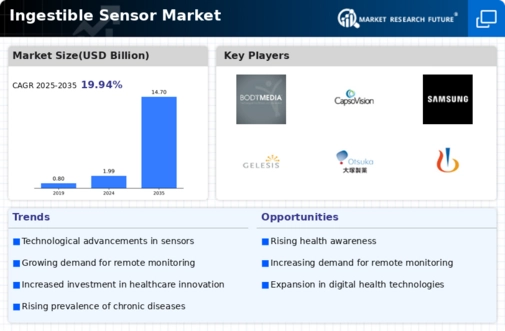Ingestible Sensor Size
Ingestible Sensor Market Growth Projections and Opportunities
The Ingestible Sensor Market is influenced by a myriad of factors that collectively shape its dynamics and growth trajectory. One of the primary drivers is the increasing prevalence of chronic diseases worldwide. With a rapidly aging population and substantial changes in lifestyles, the need for revolutionary healthcare products arises. Ingestible sensors provide an easy and non-invasive way of monitoring various health parameters, which makes them popular among those living with chronic disorders such as diabetes, hypertension or gastrointestinal conditions.
Additionally, the technological advancements play a vital role in driving forward this market. The field of ingestible sensors has progressed significantly due to the steady developments in sensor technology, data analytics, and connectivity. These innovations not only improve the accuracy of health monitoring but also increase efficiency and usability in these devices. With the wireless transmission of real-time data from integrated sensors, nurses can make timely decisions by remotely monitoring patients.
The Ingestible Sensor Market is also largely influenced by regulatory initiatives and approvals. Stringent regulatory frameworks keep a check on these devices, assuring their safety and efficacy among consumers as well as health care providers. In light of the attention that regulatory bodies around the world are paying to sensors’ ingestible potential and with more streamlined approval processes, efficient market penetration can be achieved. On the other hand, delays and uncertainties related to regulatory approvals can slow down market development as well as pose a threat for manufacturers.
The economic setting also contributes to market dynamics. The price and availability of healthcare solutions are critical in determining the rate at which ingestible sensors are adopted. Economic variables like disposable income, healthcare expenditure and insurance coverage have an influence on consumer’s willingness to invest in these devices. With a reduction in the expenses of manufacturing as economies are achieved, ingestible sensors may become cheaper and consequently increases market penetration.
The collaborations and partnerships between companies in the healthcare environment are another important driver for Ingestible Sensor Market. Through the collaboration between sensor manufacturers, pharmaceutical companies and health providers there are well-integrated solutions which provide all round health monitoring n d management. This kind of collaborations can speed up the research and development process, ensure innovation in addition to increasing market penetration by ingestible sensors.
Consumer awareness and acceptance is also a significant driver of market dynamics. Given that people become more health aware and desire to adopt preventive approaches in their lives, the demand for ingestible sensors is anticipated to increase. Educational initiatives, marketing campaigns, and testimonials from early adopters contribute to building awareness and fostering a positive perception of these technologies among the general public.










Leave a Comment